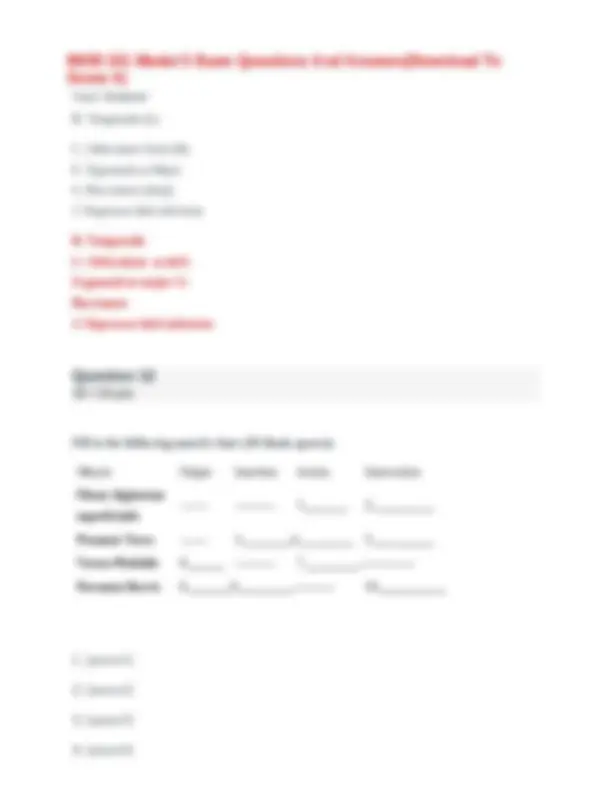
























Study with the several resources on Docsity

Earn points by helping other students or get them with a premium plan


Prepare for your exams
Study with the several resources on Docsity

Earn points to download
Earn points by helping other students or get them with a premium plan
Community
Ask the community for help and clear up your study doubts
Discover the best universities in your country according to Docsity users
Free resources
Download our free guides on studying techniques, anxiety management strategies, and thesis advice from Docsity tutors
A series of exam questions and answers related to human anatomy and physiology, specifically covering topics such as muscles, nerves, and muscle contractions. Students can use this document to review and study for exams, quizzes, or assignments.
Typology: Exams
1 / 30

This page cannot be seen from the preview
Don't miss anything!























Smooth and cardiac muscle tissue are both under voluntary control. True False The lumbar plexus is part of the central nervous system. True False False- this is a peripheral nerve
A motor signal is a signal that is sent from a muscle to the central nervous system. True False False- this is sensory input The cervical plexus contains nerves that innervate the thigh. True False Answer the following short-answer question:
Acetylcholine is what type of substance? Your Answer: Neurotransmitter. Neurotransmitter Answer the following short-answer question: During a muscle contraction which protein myofilament is pulled along? Your Answer: Actin. Actin Answer the following short-answer question: What is the name of the thin myofilament? Your Answer: Actin. Actin
Answer the following short-answer question: What must occur for a muscle contraction to stop? Your Answer: When nerve impulses no longer stimulate the muscle fiber, contraction stops. Calcium ions return to sarcoplasmic reticulum and the muscle can relax.
Label the following five muscles: B: C: E: G: J:
BIOD 151 Modul 5 Exam Questions And Answers(Download To Score A) Your Answer: Question 12
B: Temporalis (L) C: Orbicularis Oculi (R) E: Zygomaticus Major G: Buccinator (deep) J: Depressor labii inferioris B: Temporalis C: Orbicularis oculi E: Zygomaticus major G: Buccinator J: Depressor labii inferioris Fill in the following muscle chart (10 blank spaces): Muscle Origin Insertion Action Innervation Flexor digitorum superficialis
Pronator Teres ------- 3. 4. 5. Vastus Medialis 6. ---------- 7. -------------- Peroneus Brevis 8. 9. ----------- 10.
Question 13
BIOD 151 Modul 5 Exam Questions And Answers(Download To Score A) Your Answer: 1- Flexion of the wrist and digits 2-5 (middle and proximal phalanx) 2- Median nerve 3-Mid-lateral surface of radius 4- Pronation 5- Median nerve 6- Intertrochanteric line of femur 7- Knee extension 8- Lateral, distal fibula 9- Lateral side of 5th metatarsal 10- Superficial peroneal nerve
**1. Flexion of the wrist and digits 2-
BIOD 151 Modul 5 Exam Questions And Answers(Download To Score A) Your Answer: A. Extend head/neck B. Compress cheeks
BIOD 151 Modul 5 Exam Questions And Answers(Download To Score A) Semispinalis capitis Splenius Capitis Sternocleidomastoid (Bilateral neck flexion, unilateral turns face) Scalenes
Question 16
BIOD 151 Modul 5 Exam Questions And Answers(Download To Score A) Your patient is having difficulty when asked to bend his spine backward. What muscle is involved? Spinalis thoracis (Extensor of the vertebral column) Scalenes External oblique Internal oblique Rectus abdominis Question 15
Question 18
Question 19
BIOD 151 Modul 5 Exam Questions And Answers(Download To Score A) True (A band contains thick filaments and thin filaments) False Which muscle contracts to enable the main effort required to stand on your toes? Biceps femoris Quadriceps Gastrocnemius Tibialis anterior When gluteus maximus contracts, which bone is pulled posteriorly by this muscle? Tibia
BIOD 151 Modul 5 Exam Questions And Answers(Download To Score A) Ilium Ulna
BIOD 151 Modul 5 Exam Questions And Answers(Download To Score A) Question 21
Contraction of results in? obturator externus, spine flexion obturator externus, spine extension
Question 22
BIOD 151 Modul 5 Exam Questions And Answers(Download To Score A) iliacus, hip flexion iliacus, hip extension When piriformis contracts, what action(s) will not occur at the hip? A. Internal rotation B. Lateral rotation C. Adduction D. Flexion